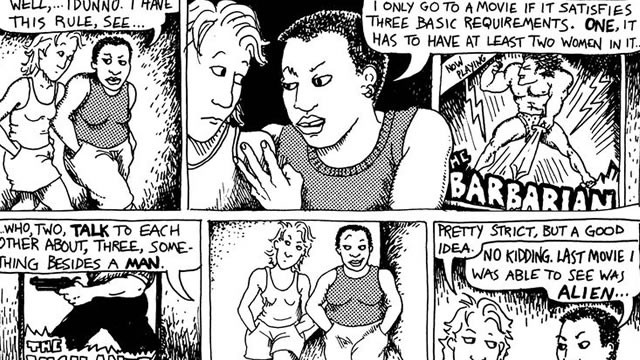
In 1985, Alison Bechdel’s comic Dykes to Watch Out For released a little strip that has influenced how we think about cinema to this day. Titled “The Rule,” it was what would become The Bechdel Test, and it had three simple criteria for movies: 1. There have to be at least two named women in it 2. who talk to each other 3. about something other than a man.
That’s it. That’s the test. While it has since been an unofficial way to gauge gender disparity in film, now a number of Swedish theaters are taking things to a new level by assigning ratings to their films based upon whether or not they pass the test. Something like The Hunger Games, for example, which passes the Bechdel Test, gets an “A” rating from the cinemas. And so far, the reaction has been pretty positive; four theater chains are currently employing the rating system, but with support from the state-funded Swedish Film Institute, the initiative might spread. Scandanavian TV channel Viasat Film stated that they’ll be using the ratings from now on in their film reviews and is even showing a special marathon of passing films.
It’s a progressive move, and one might argue that it’s a natural step when moviegoers are already warned about violence, sexual content and language – why not add gender bias to the pile? In an industry where women only accounted for 33 percent of all characters and 11 percent of the protagonists in the Top 100 Movies of 2011 (according to the Center for the Study of Women in Television and Film), it’s a real problem to discuss. There just simply aren’t enough solid roles for women in film.
Furthermore, Annenberg Public Policy Center at the University of Pennsylvania released a study showing that the ratio of male to female characters in movies has remained at about two to one for the last 60 years; it also showed that female characters were more likely to be seen in explicit sexual situations, while male characters were more violent.
But would rating films in theaters based on their proclivity toward gender bias do anything about these stats? If anything, it would be a better way to keep track of the number of films that come out each year that feature biased themes, and those films that pass the test. By looking at what gets that coveted “A” rating, and what failed to make the grade, perhaps next year’s batch of films will strive harder for success.
Here’s where it gets tricky: the Bechdel Test is not without major flaws. While called a “test,” it’s truly just a guideline; there are plenty of gorgeous, fantastic films with powerful female characters and feminist themes that actually don’t wind up passing the test sometimes – just as there are films that meet the criteria that don’t necessarily do anything to further gender equality or female empowerment. For example, most of the Harry Potter films don’t pass the test, despite featuring a number of insanely badass witches (including Hermione Granger, the baddest witch of all) who use their powers (and sometimes fists) to fight for the good of their world; it just so happens that the world’s largest supervillain is male, and the hero destined from birth to end that villain is also male. This does not make it a bad, or harmful film. Conversely, Sex and the City 2 passes the Bechdel Test with flying colors. I don’t feel like I have to explain why this is problematic. Sharknado – also Bechdel-worthy.
When using the guideline, it’s going to be hard to gauge what is truly a harmful film and what isn’t getting the “A” based on a technicality. Getting the Sex and the City sequels their rating is fine as long as it means that good, worthy films also get due recognition. The Hollywood Reporter made the interesting point that films made by women – also very important – may not pass; In 2010, Kathryn Bigelow became the first woman to ever win the Oscar for Best Director with The Hurt Locker, a film that did not pass the test. But doesn’t her achievement make the film, a very good film, something noteworthy?
The Bechdel Test is always something to keep in mind when watching movies and should be part of the discussion on women in film. The sad fact is that there aren’t enough roles for women, and the roles that they’re limited to need to be expanded. But making the test part of an official rating system will take away from films that celebrate women in different capacities – and that’s going to hurt, too.
